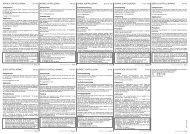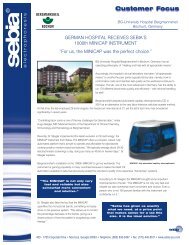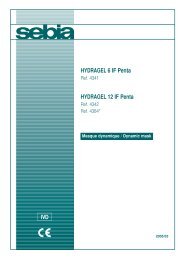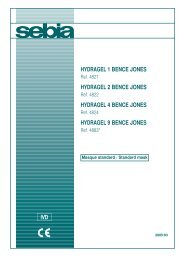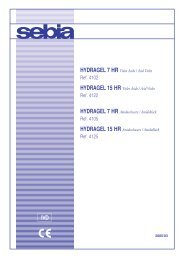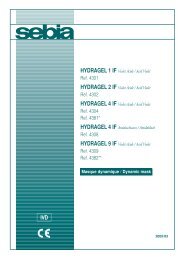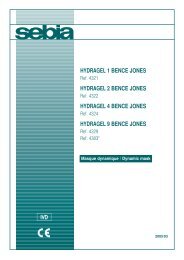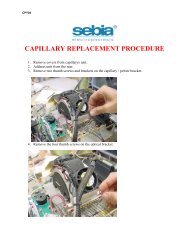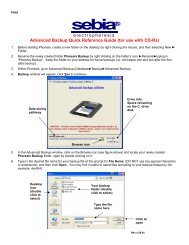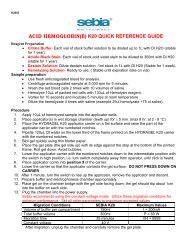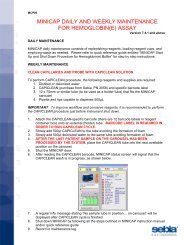CAPILLARYS HEMOGLOBIN(E)
CAPILLARYS HEMOGLOBIN(E) - Sebia Electrophoresis
CAPILLARYS HEMOGLOBIN(E) - Sebia Electrophoresis
- No tags were found...
You also want an ePaper? Increase the reach of your titles
YUMPU automatically turns print PDFs into web optimized ePapers that Google loves.
<strong>CAPILLARYS</strong> <strong>HEMOGLOBIN</strong>(E) - 2010/10<br />
Samples to avoid<br />
• Do not use unsedimented blood samples.<br />
• Avoid aged, improperly stored blood samples; the automated hemolysis of samples may be disturbed by viscous aggregates in red blood cells. Then,<br />
degradation products (as artefacts) may affect the electrophoretic pattern.<br />
PROCEDURE<br />
The <strong>CAPILLARYS</strong> system is a multiparameter instrument for hemoglobins analysis on parallel capillaries. The hemoglobins assay uses 7 of the total<br />
8 instrument capillaries to run the samples.<br />
The sequence of automated steps is as follows:<br />
• Bar code reading of sample tubes (for up to 7 tubes) and samples-racks;<br />
• Sample hemolysis and dilution from primary tubes (without any plasma) into dilution segments;<br />
• Capillary washing;<br />
• Injection of hemolyzed samples;<br />
• Hemoglobin separation and direct detection of the separated hemoglobins on capillaries.<br />
The manual steps include:<br />
• Placement of opened sample tubes in sample-racks in positions 1 to 7;<br />
• Placement of hemolysing solution tube in sample-racks in position 8;<br />
• Placement of new dilution segments in sample-racks;<br />
• Placement of racks on the <strong>CAPILLARYS</strong> instrument;<br />
• Removal of sample-racks after analysis.<br />
PLEASE CAREFULLY READ THE <strong>CAPILLARYS</strong> INSTRUCTION MANUAL.<br />
I. PREPARATION OF <strong>CAPILLARYS</strong> ANALYSIS<br />
1. Switch on <strong>CAPILLARYS</strong> instrument and computer.<br />
2. Set up the software, enter and the instrument automatically starts.<br />
3. For the <strong>CAPILLARYS</strong> CORD BLOOD procedure, the <strong>CAPILLARYS</strong> <strong>HEMOGLOBIN</strong>(E) kit is used with the "CORD BLOOD" analysis program<br />
from the <strong>CAPILLARYS</strong> instrument. To select "CORD BLOOD" analysis program and place the <strong>CAPILLARYS</strong> <strong>HEMOGLOBIN</strong>(E) buffer vial in<br />
the instrument, please read carefully the <strong>CAPILLARYS</strong> instruction manual.<br />
4. The sample rack contains eight positions for sample tubes. Place seven opened sample tubes without any plasma on each sample rack<br />
(positions 1 to 7) ; the bar code of each tube must be visible in the openings of the sample rack.<br />
IMPORTANT: If the number of tubes to analyze is less than 7, complete the sample rack with tubes containing distilled or deionized water.<br />
5. Pour 4 mL <strong>CAPILLARYS</strong> <strong>HEMOGLOBIN</strong>(E) hemolysing solution in a tube without introducing air bubbles and place it in position No. 8 on the<br />
sample rack.<br />
IMPORTANT: Ensure the absence of foam in the tube before placing it on the sample rack.<br />
6. Position a new dilution segment on each sample rack. A message will be displayed if the segment is missing.<br />
7. Slide a sample rack No. 0 with the Hb AF Control: See the previous paragraph "Hb AF Control" when using it with the <strong>CAPILLARYS</strong> CORD<br />
BLOOD procedure, part "Migration control".<br />
8. Slide the complete sample carrier(s) into the <strong>CAPILLARYS</strong> system through the opening in the middle of the instrument. Up to 13 sample racks<br />
(including the sample rack No. 0 intended for the control blood sample) can be introduced successively and continuously into the system.<br />
9. Remove analyzed sample racks from the plate on the left side of the instrument.<br />
10. Take off carefully used dilution segments from the sample rack and discard them.<br />
WARNING: Dilution segments with biological samples have to be handled with care.<br />
DILUTION - MIGRATION - DESCRIPTION OF THE AUTOMATED STEPS<br />
1. Bar codes are read on both sample tubes and sample racks.<br />
2. Samples are diluted in hemolysing solution and the sample probe is rinsed after each sample.<br />
3. Capillaries are washed.<br />
4. Diluted samples are injected into capillaries.<br />
5. Migration is carried out under constant voltage for about 8 minutes and the temperature is controlled by Peltier effect.<br />
6. Hemoglobins are detected directly by scanning at 415 nm and an electrophoretic profile appears on the screen of the system.<br />
NOTE: These automated steps described above are applied to the first introduced sample rack. The electrophoretic patterns appear after about<br />
20 minutes from the start of the analysis. For the following sample rack, the first two steps (bar code reading and sample dilution) are performed during<br />
analysis of the previous sample rack.<br />
II. RESULT ANALYSIS<br />
At the end of the analysis, relative quantification of individual hemoglobin fractions is performed automatically and profiles can be analyzed. The<br />
hemoglobin fractions, Hb A, Hb F and Hb A2 are automatically identified and the Hb F hemoglobin fraction is adjusted at a well-defined position. The<br />
resulting electrophoregrams are evaluated visually for pattern abnormalities.<br />
The potential positions of the different hemoglobin variants (identified in zones called C1 to C12) are shown on the screen of the system and indicated<br />
on the result ticket. The table in paragraph "Interpretation" shows known variants which may be present in each corresponding zone. When the<br />
software identifies a hemoglobin fraction in a defined zone, the name of this zone is framed.<br />
The identification of normal blood samples and of pathological blood samples are automatically performed and the profiles can be distinguished in the<br />
curve review window of patterns by a blue color for normal samples and a red color for pathological samples. This identification is based on the<br />
detection of abnormal fractions of hemoglobin on a pattern or on the absence of Hb F or Hb A hemoglobin fractions.<br />
The software is optimized to limit the interferences due to degraded hemoglobins on the analysis. Moreover, the software allows for the detection of<br />
low Bart’s hemoglobin concentrations which may alert the user on a probable alpha-thalassemia diagnostic.<br />
- 61 -



